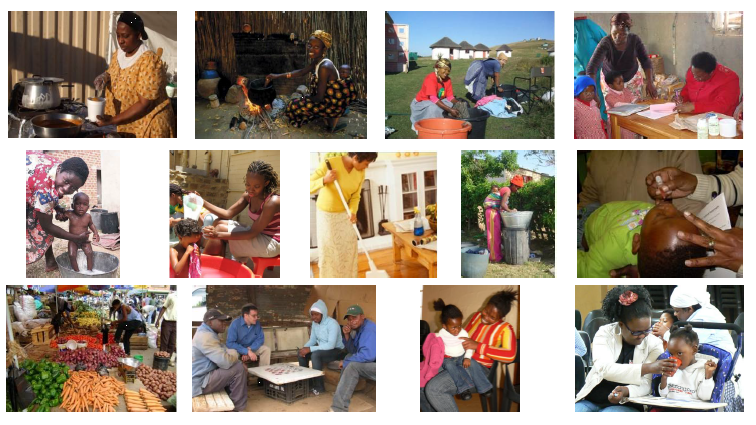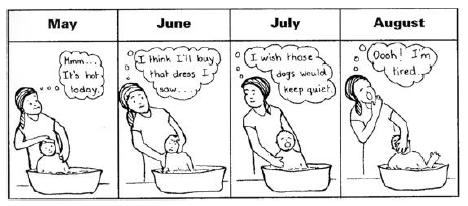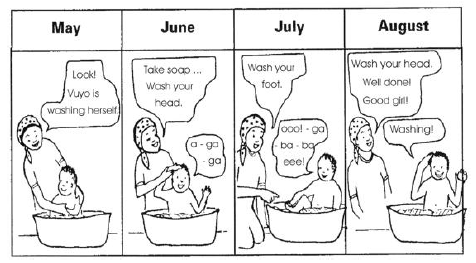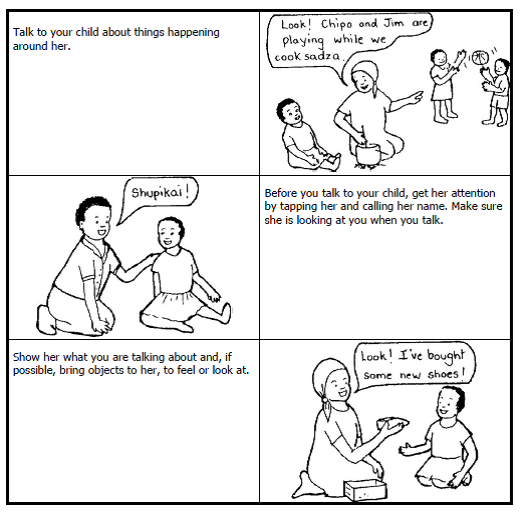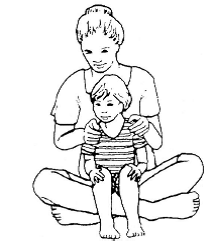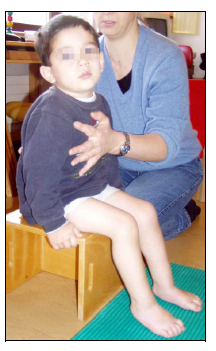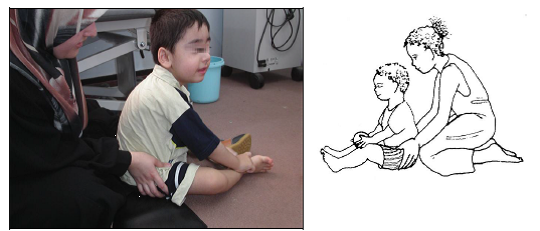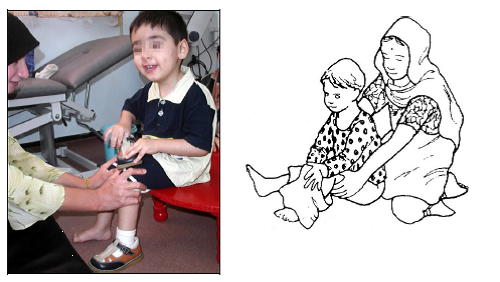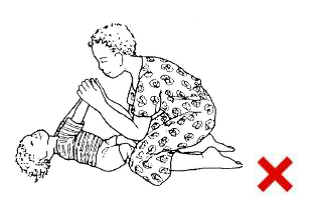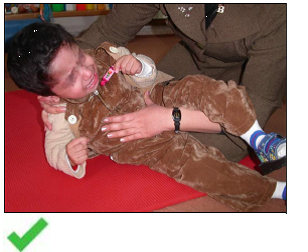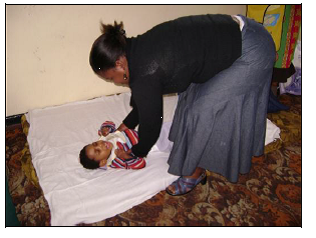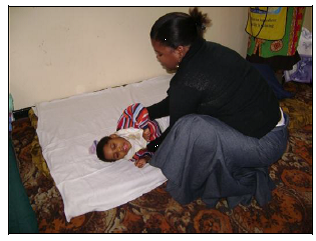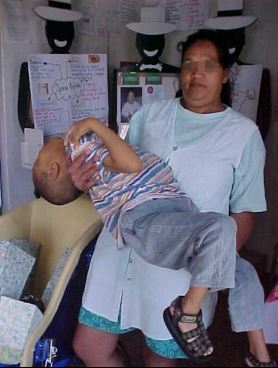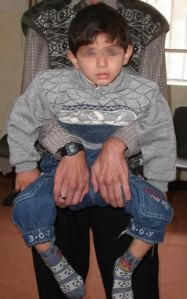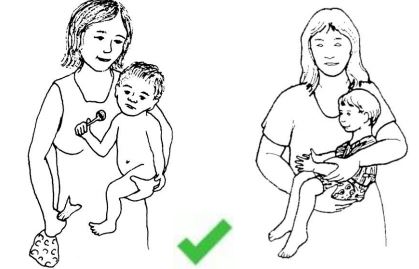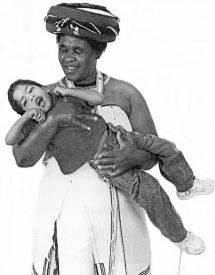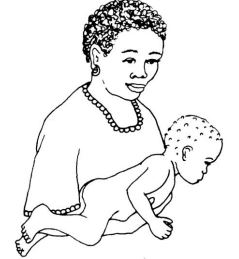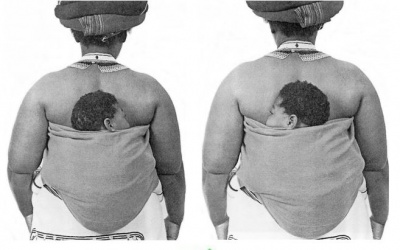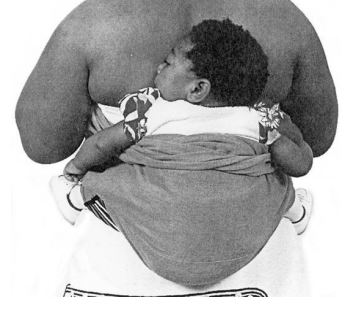Module 5: Everyday Activities: Difference between revisions
No edit summary |
(carrying pictures) |
||
| Line 233: | Line 233: | ||
<br> | <br> | ||
<br> | <br> | ||
<span style="font-size: 13.28px;">Have you tried these </span>'''''traditional positions'''''<span style="font-size: 13.28px;">?</span> | |||
<br> | <br> | ||
*Make sure her hips are open, but do not force them. | *Make sure her hips are open, but do not force them. | ||
| Line 249: | Line 243: | ||
*Each time you carry her, turn her head to the other side. | *Each time you carry her, turn her head to the other side. | ||
*The blanket can provide full muscle support, or if you put it under her arms, she will have to work to keep her head up, and be able to move her arms. | *The blanket can provide full muscle support, or if you put it under her arms, she will have to work to keep her head up, and be able to move her arms. | ||
[[Image:Carrying baby back.JPG|border|left|400x300px]] | |||
<div>[[Image:Carrying baby back2.JPG|border]]<br></div> | |||
Revision as of 09:56, 14 May 2017
Page Outcomes[edit | edit source]
When you have finished this workshop, you should have a clearer understanding about:
- How to use everyday activities to develop your child with cerebral palsy.
- You should be able to explain this to others in your family or community.
Introduction[edit | edit source]
A carer is the most important caregiver for a child with cerebral palsy. Think about the time that is spent every day with the child, doing everyday things with her.
Here is a list of some everyday activities:
- Dressing the child
- Cooking, cleaning, and doing the washing going on an outing
- Toileting the child feeding your child
- Giving the child medication helping her get to sleep
- Visiting friends
- Playing with the child going to the clinic…
This is what the child needs to learn:
- Moving and balancing, using her hands,
- Communicating and interacting,
- Learning to be as independent as possible in self care activities, relating to others,
- Thinking and playing,
- Moving from place to place.
- With all the washing and feeding and dressing and giving medication and other things that you have to do with your child daily, you may already be very busy and feel quite stressed. And you may be caring for other children too.
A common thought is when the carer will find the time and energy to do a lot of exercises to help the child develop.
All of these daily things need to be done with the child anyway. So if they can do them in such a way that they are stimulating the child at the same time, this will help the child a lot with her development.
We will now learn how you can use these everyday activities to help your child develop. Look at these picture strip stories:
uMama KaSive:
This story demonstrates how to communicate with a child in an everyday situation. We first discussed this in our session about communication.
Look at these pictures again. They illustrate some of the things that we discussed about helping a child learn to communicate.
Notice how Vuyo‟s mother in the second bathing picture strip uses these ideas to help her child to learn to communicate.
So far, we have concentrated on only one skill – communication. We now need to look at the other parts.
Movement[edit | edit source]
The caregiver is helping the child:
- to sit by holding her in a helpful position while she moves her arm to reach up to her head.
- by encouraging her to balance while moving her limbs. (In the top row, the caregiver always holds on to her child, as she has never become aware, or given the child opportunity, to learn some balancing for herself).
Using her Hands
- The caregiver involves the child in the washing by helping her to hold the soap or wash cloth
Social and Emotional
- The child is learning a self-help skill, bathing. Over the months, this child is learning to bath herself, with just the amount of help and encouragement she needs on each occasion.
Thinking and Playing
- The child is playing and having fun while learning.
- The caregiver first performs the activity but involves her by communicating what she is doing - > then she involves the child by helping the child to do it with her - > then she lets the child do more by herself and only points out what is needed -> then makes the request and stands back while the child does it herself.
Summary
A helpful position makes it easier for a child to be more involved with everyday activities. She may be able to look around and watch what is happening in the room; or it may become easier to communicate with others. She can also use her arms more easily during activities
Using a helpful position during everyday activities[edit | edit source]
In Module 3 we learned about positions that can either help or hinder a child‟s development. To refresh your memory take a look at Module 3. Now we are going to look at how to support each joint in turn:
Shoulders:
|
Chest:
|
'Hips:
'Knees:
Earlier we talked about you needing to do all the daily activities with your child. And that if you can do them in such a way that you are stimulating the child at the same time, then this will help the child a lot with her development.
Let's look at some examples of how we can use different everyday situations to help children to develop.
One of the things that a caregiver does many times a day is pick up and carry her child. Let‟s look at how to do this so that it helps her develop
Positions that Promote Development[edit | edit source]
Picking up[edit | edit source]
| |
|
Taking Care of your Back[edit | edit source]
| |
|
Carrying[edit | edit source]
| Poor way This picture shows a poor carrying position.
| |
| Helpful way
Head and body
Legs and feet
Shoulders and arms
|
You can also try these positions if your child has uncontrolled movements.
And if your child is stiff and tends to curl forwards, try carrying her like this:
And if one side is more stiff than the other, try to stretch that side. But don‟t always carry her only on one side. Sometimes change to the other side.
Try carrying your baby in this position on your forearm. It can help her to develop control of her head when lying face down.
And when she's bigger youcan still carry her in this face down position. Babies and children get very few opportunities these days to be face down. A
nd so the development of extension is becoming a problem. Even though the legs are straight, they are separate and relaxed. If the child‟s legs are stiff and crossed, this is not a good position to use.
However
- If the child‟s legs are stiff and crossed, this is not a good position to use.
- Remember what we said about children who push back strongly with their heads all the
instead of being helpful.
Have you tried these traditional positions?
- Make sure her hips are open, but do not force them.
- Wrap her arms around you with her thumbs facing up.
- Each time you carry her, turn her head to the other side.
- The blanket can provide full muscle support, or if you put it under her arms, she will have to work to keep her head up, and be able to move her arms.
